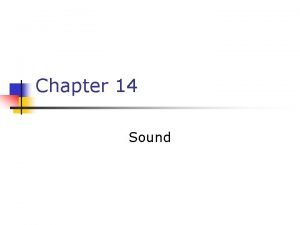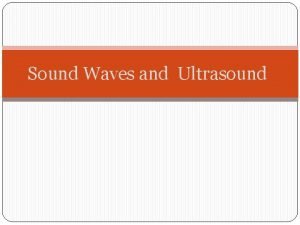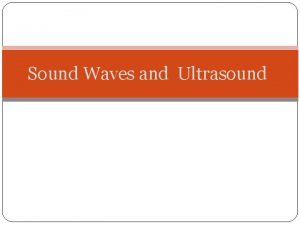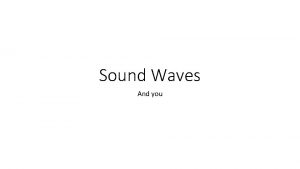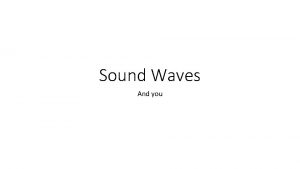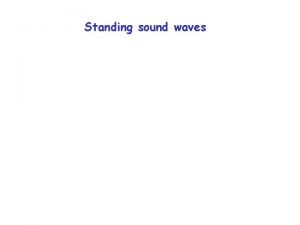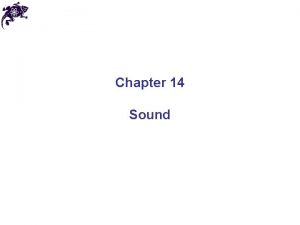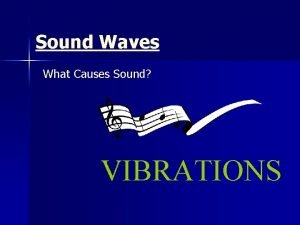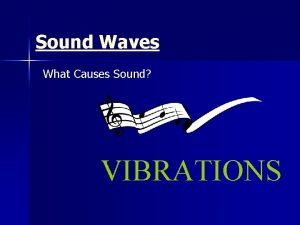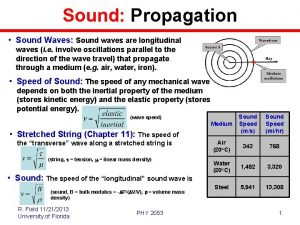Sound Waves The production of sound from a



















- Slides: 19

Sound Waves The production of sound from a sound wave begins with a vibrating object.

Sound waves n Compression-a region of high molecular density and high air pressure is a compression. n n Rarefaction-region of lower density and pressure. Classic example-tuning fork.

Facts about sound waves: n n The vibrations of sound waves are parallel, so they are longitudinal waves. Sound waves that the human ear can hear are audible sound waves with frequencies between 20 and 20, 000 Hz. If sound waves have frequencies less than 20 -Hz, they are termed infrasonic waves. Those with frequencies above 20, 000 -Hz are ultrasonic. Dogs can hear ultrasonic waves that humans cannot.

Pitch and speed of sound: n Pitch is a measure of how high or low a sound is perceived to be, depending on the frequency of the sound wave. Pitch also depends on background noise and loudness. n The speed of sound depends on the medium. Sound waves can travel through solids, liquids, and gases. Solid particles respond more quickly to a disturbance than gas because solid molecules are closer together. As a result, sound waves travel through solids faster.

The speed of sound depends on the temperature of the medium. n n Sound waves travel away from a vibrating source in three dimensions. The Doppler Effect: An observed change in frequency when there is relative motion between the source of waves and an observer. (First described by Christian Doppler). E. g. ambulance approaching an observer.

Sound Intensity and resonance: n n n Intensity-the rate at which energy flows through a unit area perpendicular to the direction of wave motion. Intensity=∆E/∆t divided by area=Power/area SI unit of power=watt Intensity=watts per square meter. Intensity of a spherical wave: intensity equals ______. The intensity of a sound wave decreases as the distance from the source (r) increases.

Sample Problem A: n n What is the intensity of the sound waves produced by a trumpet at a distance of 3. 2 -m when the power output of the trumpet is 0. 20 -W? Assume that the sound waves are spherical. Intensity=

Intensity and frequency determine which sounds are audible. n n The softest sounds that can be heard by the average human ear occur at a frequency of about 1000 -Hz, and an intensity of 1. 0 x 10 -12 -W/m 2. These sounds are said to be at the threshold of hearing. The loudest sounds that the human ear can tolerate have an intensity of about 1. 0 -W/m 2. This is the threshold of pain because sounds with greater intensities can produce pain in addition to hearing. Exposure to sounds above threshold of pain cause immediate damage to the ear.

Sound Intensity Continued… n n n Relative intensity-the ratio of the intensity of a given sound wave to the intensity at the threshold of hearing. Decibel-a dimensionless unit that describes the ratio of two intensities of sound (db). Forced vibration is exhibited with a pendulum being set in motion when its vibrations are transferred by rubber band to the other pendulums and those others begin vibrating. Every pendulum will vibrate at a certain frequency known as its natural frequency. The human ear transmits vibrations that cause nerve impulses.

The Human Ear

The human ear transmits vibrations that cause nerve impulses. The human ear is divided into three regions: -outer -inner -middle *Sound waves travel through these regions and are transmitted to the brain as impulses through nerve endings on the basilar membrane. n

Harmonics n The ends of strings that cannot vibrate must always be nodes, N. The center of a stringed instrument experiences the most displacement and is called the antinode, A. The distance from node to node is always half a wavelength, so the string length, L must equal wavelength 1 divided by 2. ( ). Thus, the wavelength is twice the string length.

Fundamental frequency n n n This is the frequency of the vibrating string. It is the lowest possible frequency of a standing wave on a string. Harmonic series-a series of frequencies that includes the fundamental frequency and integral multiples of the fundamental frequency. The fundamental frequency, f 1 corresponds to the first harmonic, the next frequency, f 2 corresponds to the second harmonic and so on. Each harmonic is an integral multiple of the fundamental frequency.

Harmonic series of standing waves on a vibrating string: n n n=harmonic number fn=nv/2 L v is the speed of the waves on the vibrating string, and L is length of vibrating string If the string vibrates at one of these frequencies, the sound waves produced in the surrounding air will have the same frequency.

Harmonics n n Harmonic series of a pipe open at both ends: fn=nv/2 L Harmonic series of a pipe closed at one end: fn=nv/4 L

Sample Problem B: n What are the first three harmonics in a 2. 45 -m long pipe that is open at both ends? What are the first three harmonics of this pipe when one end of the pipe is closed? Assume that the speed of sound in air is 345 -m/s.

Harmonics: n n Trumpets, saxophones, and clarinets are similar to a pipe closed at one end. Open holes in many instruments affect the harmonics. Harmonics accounts for sound quality, or timbre. Each instrument has its own characteristic mixture of harmonics at varying intensities.

Harmonics n n Spectrum of sound is the mixture of harmonics that produces the characteristic sound of an instrument. Fundamental frequency determines pitch. Beat-the periodic variation in the amplitude of a wave that is the superposition of two waves of slightly different frequencies. Sound waves at slightly different frequencies produce beats. The number of beats per second corresponds to the difference between frequencies.

An orchestra tunes up for the big concert by playing an A, which resounds with a fundamental frequency of 440 -Hz. Find the first and second overtones of this note. Aaron blows across the opening of a partially filled 20. 0 -cm high soft drink bottle and finds that the air vibrates with a fundamental frequency of 472 -Hz. How high is the liquid in the bottle?
 Sound waves are transverse waves true or false
Sound waves are transverse waves true or false Difference between mechanical and electromagnetic waves
Difference between mechanical and electromagnetic waves What type of waves are sound waves? *
What type of waves are sound waves? * Sound waves longitudinal waves
Sound waves longitudinal waves Sebutkan alur produksi multimedia
Sebutkan alur produksi multimedia Constructive waves and destructive waves difference
Constructive waves and destructive waves difference Mechanical and electromagnetic waves venn diagram
Mechanical and electromagnetic waves venn diagram Long waves and short waves
Long waves and short waves Seismic waves
Seismic waves Mechanical waves and electromagnetic waves similarities
Mechanical waves and electromagnetic waves similarities Seismic waves are mechanical waves
Seismic waves are mechanical waves Parts of a longitudinal wave
Parts of a longitudinal wave Examples of mechanical and electromagnetic waves
Examples of mechanical and electromagnetic waves Compare and contrast p waves and s waves using venn diagram
Compare and contrast p waves and s waves using venn diagram Mechanical waves examples
Mechanical waves examples Mechanical waves and electromagnetic waves similarities
Mechanical waves and electromagnetic waves similarities Magnetostriction oscillator
Magnetostriction oscillator Sound waves
Sound waves Literary devices in the sound of waves
Literary devices in the sound of waves Tuning fork sound waves
Tuning fork sound waves



















